Study on Key Parameter Design and Adaptability Technology of the 110 Mining Method for the Yuwang NO.1 Coal Mine in the Diandong Mining Area
Abstract
1. Introduction
2. Overview of Yuwang No.1 Coal Mine
2.1. Overview of the Mine
2.2. Overview of the Working Face
2.3. Engineering Geology
3. Design of Key Parameters
3.1. Roof-Cutting Height
3.1.1. Preliminary Design
3.1.2. Numerical Simulation Validation
- (1)
- Vertical stress distribution law at different roof-cutting heights
- (2)
- Horizontal stress distribution at different roof-cutting heights
- (3)
- Vertical displacement at different roof-cutting heights
- (4)
- Horizontal displacement at different roof-cutting heights
- (5)
- The range of the plastic zone with different roof-cutting heights
3.2. Roof-Cutting Angle
3.2.1. Preliminary Design
3.2.2. Numerical Simulation Validation
- (1)
- Vertical stress at different roof-cutting angles
- (2)
- Horizontal stress at different cutting angles
- (3)
- Vertical displacement of different roof-cutting angles
- (4)
- Horizontal displacement of different cutting angles
- (5)
- The range of the plastic zone at different roof-cutting angles
3.3. Blasting Parameters
3.3.1. Blast Modeling
- (1)
- Explosives
- (2)
- Rocks
- (3)
- Shaped charge tube
- (4)
- Air
3.3.2. Numerical Simulation Analysis
- (1)
- Numerical analysis of single-hole blasting
- (2)
- Numerical simulation of multi-hole cumulative blasting
- (3)
- Numerical simulation of spaced-hole cumulative blasting
4. Special Design for Gas Prevention and Control
4.1. Closure Design of the Goaf
- (1)
- Windpipe cloth + slurry spraying closure program
- (2)
- Cement blanket + local slurry spraying reinforcement closure program (shown in Figure 32)
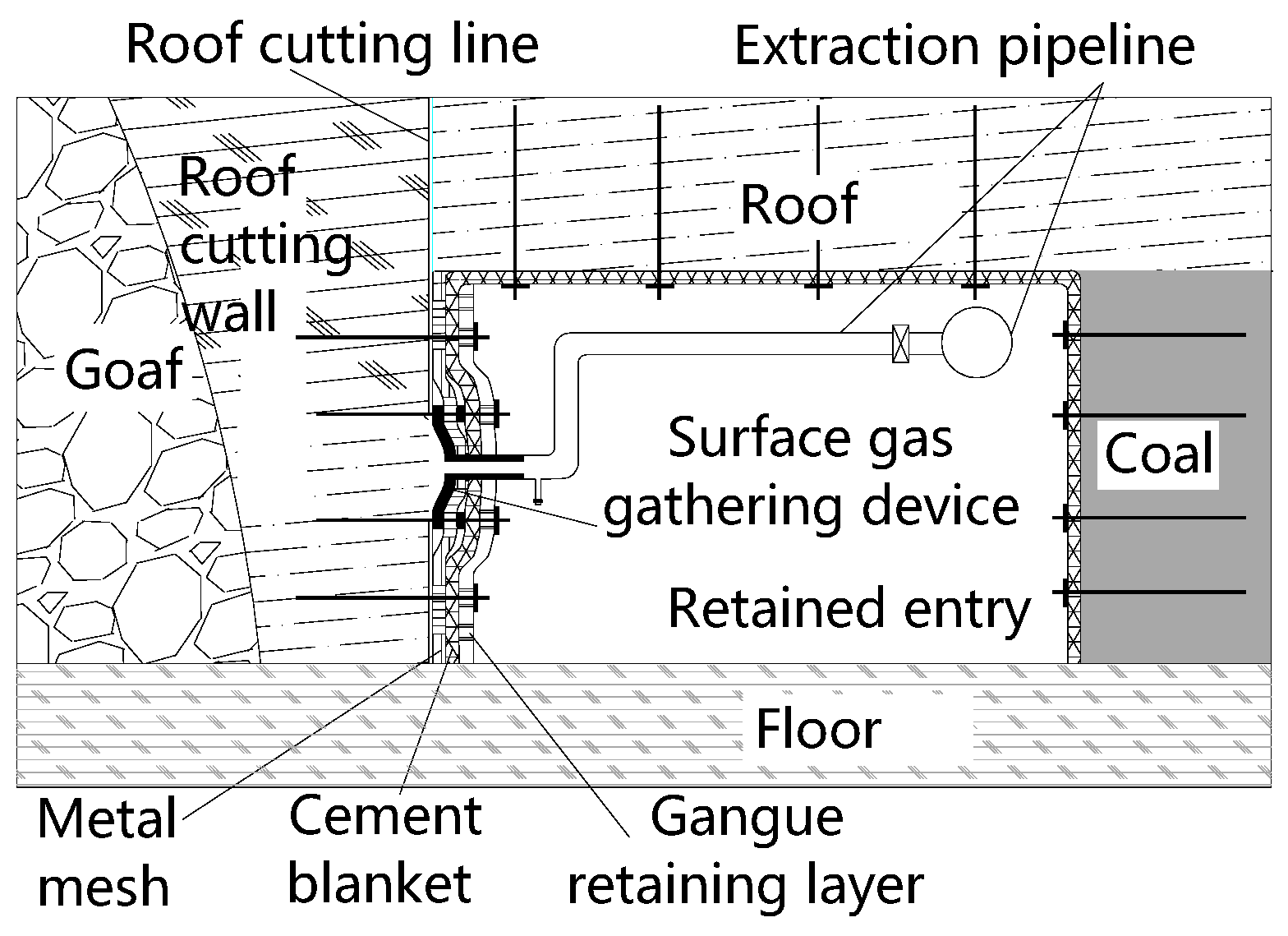
- (3)
- Masonry closure wall closure program (shown in Figure 33)

4.2. Design of Goaf Gas Extraction
- (1)
- Buried pipe method of extraction of gas from the goaf
- (2)
- Gas collection device to extract gas from the goaf
4.3. Field Effect Investigation Plan
5. Conclusions and Follow-Up Plan
5.1. Conclusions
- (1)
- This study analyzed the geological conditions of the Yuwang No.1 Coal Mine in the Huaneng Eastern Yunnan Mining Area, summarized the geological characteristics of the 110 mining method test working face, and analyzed the practice feasibility of the 110 mining method according to the geological characteristics of “one soft, one low, two high, and two complex”;
- (2)
- Based on engineering experience, calculations, and analyses, the key parameters of roof cutting in the test working face of the Yuwang No.1 Coal Mine were designed. With the help of numerical simulations, the roof-cutting height, roof-cutting angle, and blasting parameters were numerically simulated and analyzed. The key parameters of roof cutting in the test working face were obtained as follows: the depth of roof cutting is 7 m, the angle of roof cutting is 15°, and the blasting method is multi-hole blasting with a spacing of 500 mm;
- (3)
- In view of the coal and gas outburst and the occurrence conditions of coal seams in the Yuwang No.1 Coal Mine, a variety of goaf closure design schemes and goaf gas drainage design schemes were proposed, and the on-site effect inspection scheme was given.
5.2. Follow-Up Plan
Author Contributions
Funding
Data Availability Statement
Acknowledgments
Conflicts of Interest
References
- Kang, H.P.; Niu, D.L.; Zhang, Z.; Lin, J.; Li, Z.H.; Fan, M.J. Deformation Characteristics of Surrounding Rock and Supporting Technology of Gob-side Entry Retaining in Deep Coal Mine. Chin. J. Rock Mech. Eng. 2010, 29, 1977–1987. [Google Scholar]
- Gao, X.; Liu, S.; Zhao, C.; Yin, J.; Fan, K. Damage Evolution Characteristics of Back-Filling Concrete in Gob-Side Entry Retaining Subjected to Cyclical Loading. Minerals 2022, 15, 5772. [Google Scholar] [CrossRef]
- Xue, Y. From Tradition to Modern Times: Evolution of Coal Mining Technology in China. J. HuBei Polytech. Univ. (Humanit. Soc. Sci.) 2013, 30, 7–15. [Google Scholar]
- He, M.; Song, Z.; Wang, A.; Yang, H.; Qi, H.; Guo, Z. Theory of longwall mining by using roof cuting shortwall team and 110 method—The third mining science and technology reform. Coal Sci. Technol. Mag. 2017, 1, 1–9+13. [Google Scholar]
- Ghabraie, B.; Ren, G.; Smith, J.; Holden, L. Application of 3D laser scanner, optical transducers and digital image processing techniques in physical modelling of mining-related strata movement. Int. J. Rock Mech. Min. Sci. 2015, 80, 219–230. [Google Scholar] [CrossRef]
- Hu, J.; Braytsev, U. Coal Seam Coal-Free Column Mining; Cui, M., Translator; China University of Mining and Technology Press: Beijing, China, 1991. [Google Scholar]
- Shi, J.; Ma, N.; Bai, Z. Analysis on Roof Broken Location of Gateway Retained along Goaf and Technology of Roof Support. Coal Sci. Technol. 2013, 41, 35–37+42. [Google Scholar]
- Li, Y.; Hua, X. Mechanical analysis of stability of key blocks of overlying strata for gob-side entry retaining and calculating width of roadside backfill. Rock Soil Mech. 2012, 33, 1134–1140. [Google Scholar]
- Ajayi, S.A.; Ma, L.; Spearing, A.J. Spearing. Ground Stress Analysis and Automation of Workface in Continuous Mining Continuous Backfill Operation. Minerals 2022, 12, 754. [Google Scholar] [CrossRef]
- He, M.C.; Xie, H.P.; Peng, S.P.; Jiang, Y.D. Study on Rock Mechanics in Deep Mining Engineering. Chin. J. Rock Mech. Eng. 2005, 24, 2803–2813. [Google Scholar]
- He, M.C.; Ma, X.G.; Niu, F.L.; Wang, J.; Liu, Y.X. Adaptability research and application of rapid gob-side entry retaining formed by roof cutting and pressure releasing with composite roof and medium thick coal seam. Chin. J. Rock Mech. Eng. 2018, 37, 2425–2434. [Google Scholar]
- He, M.; Ma, X.; Yu, B. Analysis of Strata Behavior Process Characteristics of Gob-Side Entry Retaining with Roof Cutting and Pressure Releasing Based on Composite Roof Structure. Shock Vib. 2019, 2019, 2380342. [Google Scholar] [CrossRef]
- Ma, X.; He, M.; Sun, J.; Wang, H.; Liu, X.; Zhen, E. Neural Network of Roof Cutting Blasting Parameters Based on Mines with Different Roof Conditions. Energies 2018, 11, 3468. [Google Scholar] [CrossRef]
- Sun, X.M.; Liu, X.; Liang, G.F.; Wang, D.; Jiang, Y.L. Key Parameters of Gob-Side Entry Retaining Formed by Roof Cut and Pressure Releasing in Thin Coal Seams. Chin. J. Rock Mech. Eng. 2014, 33, 1449–1456. [Google Scholar]
- Guo, Z.B.; Wang, J.; Cao, T.P.; Chen, L.; Wang, J. Research on key parameters of gob-side entry retaining automatically formed by roof cutting and pressure release in thin coal seam mining. J. China Univ. Min. Technol. 2016, 45, 879–885. [Google Scholar]
- Ma, X. Research on Key Technologies and Rock Pressure Law of 110 Mining Method with Compound Hard Roof in Tashan Coal Mine; China University of Mining and Technology: Beijing, China, 2019. [Google Scholar]
- China Huaneng Group Co. China Huaneng Group Co., Ltd.’s “14th Five-Year” Development Plan; China Huaneng Group Co.: Beijing, China, 2022. [Google Scholar]
- Huaneng Coal Co. Coal Industry “14th Five-Year” Scientific and Technological Innovation Plan; China Huaneng Group Co., Ltd.: Beijing, China, 2022. [Google Scholar]
- Zhao, R. Comprehensive Detection of Hydrogeological Conditions and Design of Water Prevention in Panel 101 of the Yuwang Coal Mine No.1 in Yunnan Province; China University of Mining and Technology: Beijing, China, 2021. [Google Scholar]
- Gan, X. Hydrogeological condition analysis and prevention countermeasures of No.1 mine field of Yuwang Coal Mine. J. Beijing Polytech. Coll. 2021, 20, 1–4. [Google Scholar]
- Mahoutian, M.; Shekarchi, M.; Libre, N.A. Application of steel fiber reinforced lightweight aggregate concrete in underground mining. J. Min. Sci. 2011, 47, 606–617. [Google Scholar] [CrossRef]
- Ma, X.; He, M.; Li, W.; Wang, Y.; Li, L.; Sun, X.; Li, Y.; Gu, L.; Sha, X. Research and application of open-off cut roof cutting pressure releasing technology. Adv. Civ. Eng. 2021, 5, 9989213. [Google Scholar] [CrossRef]
- Park, S.J.; Kim, G.J.; Kwak, H.G. Characterization of stress-dependent ultrasonic nonlinearity variation in concrete under cyclic loading using nonlinear resonant ultrasonic method. Constr. Build. Mater. 2017, 145, 2172–2282. [Google Scholar] [CrossRef]
- Duchnowski, R.; Wyszkowska, P. Unstable Object Points during Measurements—Deformation Analysis Based on Pseudo Epoch Approach. Sensors 2022, 22, 9030. [Google Scholar] [CrossRef]
- T/CCCA 002-2018; Standard for 110 Law of Self-Made Lane without Coal Columns. China Coal Construction Association: Beijing, China, 2018.
- Fei, H.; Guo, Y. Study on optimized selection for row interval time of staggered sector deep-hole caving method based on LS-DYNA. J. Saf. Sci. Technol. 2022, 18, 127–134. [Google Scholar]
- Breccolotti, M.; Bonfigli, M.F.; D’Alessandro, A.; Materazzi, A.L. Constitutive modeling of plain concrete subjected to cyclic uniaxial compressive loading. Constr. Build. Mater. 2015, 94, 172–180. [Google Scholar] [CrossRef]
- Verma, A.K.; Singh, T.N. Modeling of a jointed rock mass under triaxial conditions. Arab. J. Geosci. 2010, 3, 91–103. [Google Scholar] [CrossRef]
- He, M.; Ma, X.; Wang, J.; Zhang, J.; Liu, Y.X. Feature Analysis of Working Face Strata Pressure with Roof Cutting Pressure Releasing in Medium-thick Seam and Compound Roof Condition. Chin. J. Rock Mech. Eng. 2018, 37, 2641–2654. [Google Scholar]


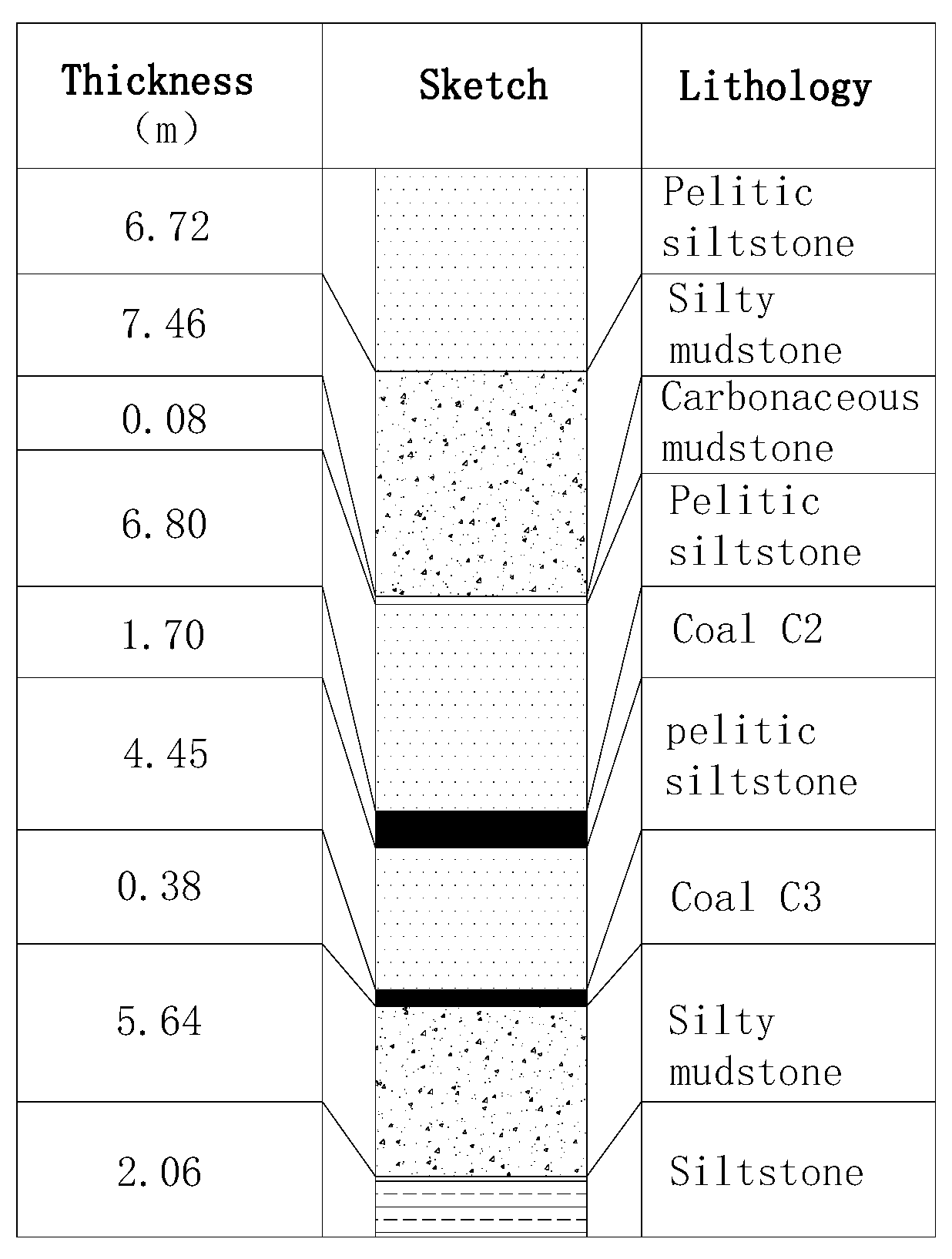
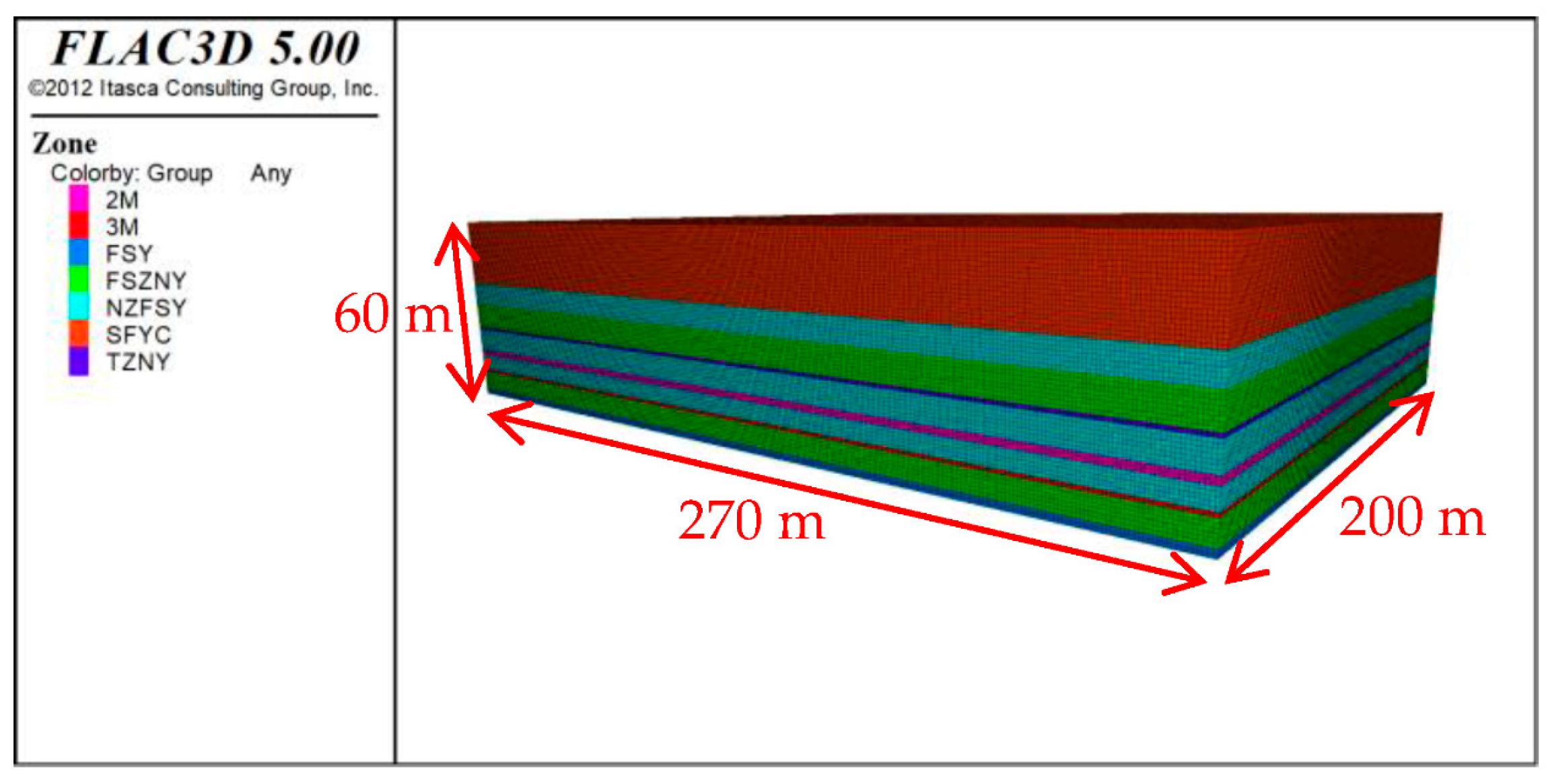
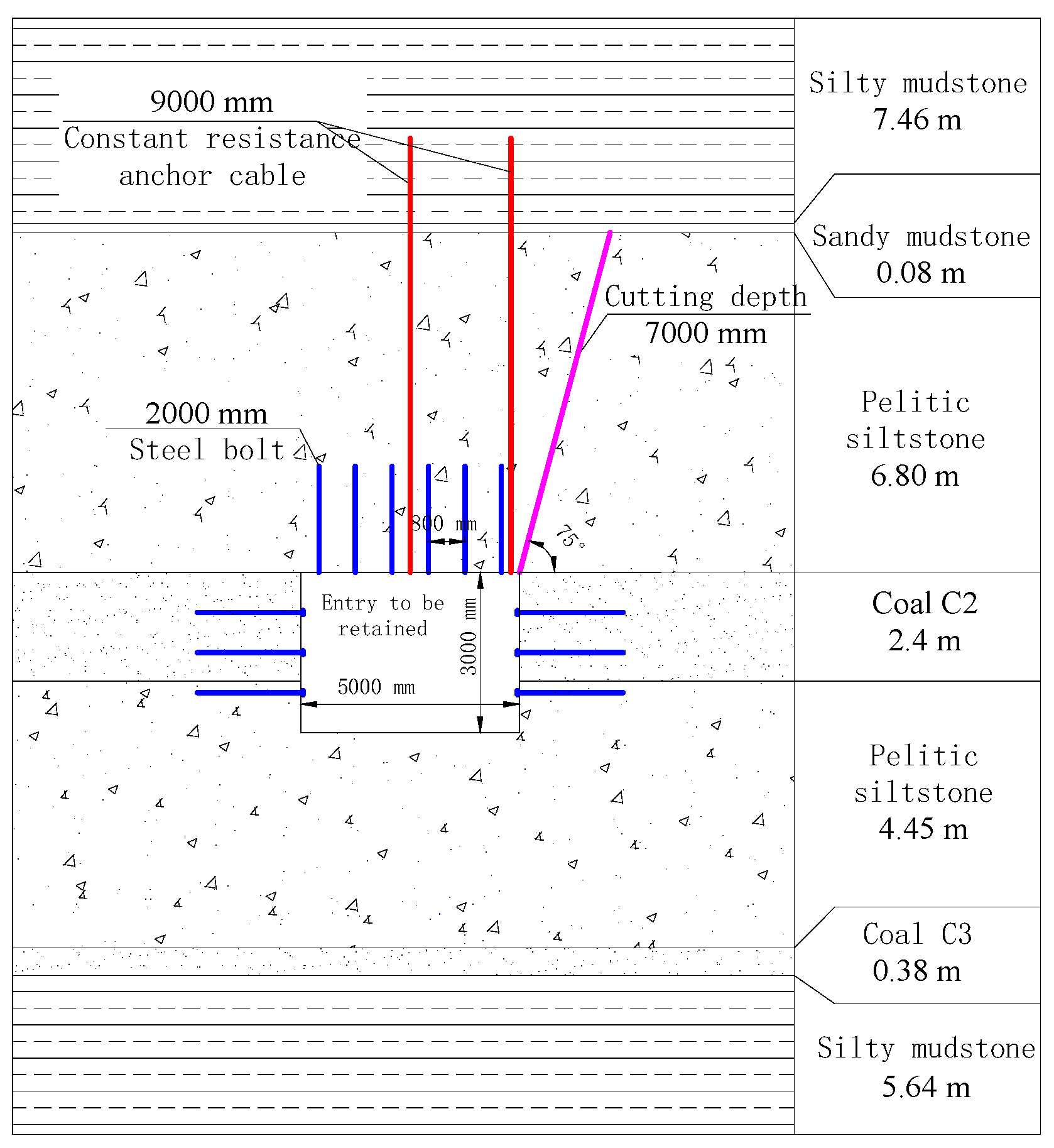


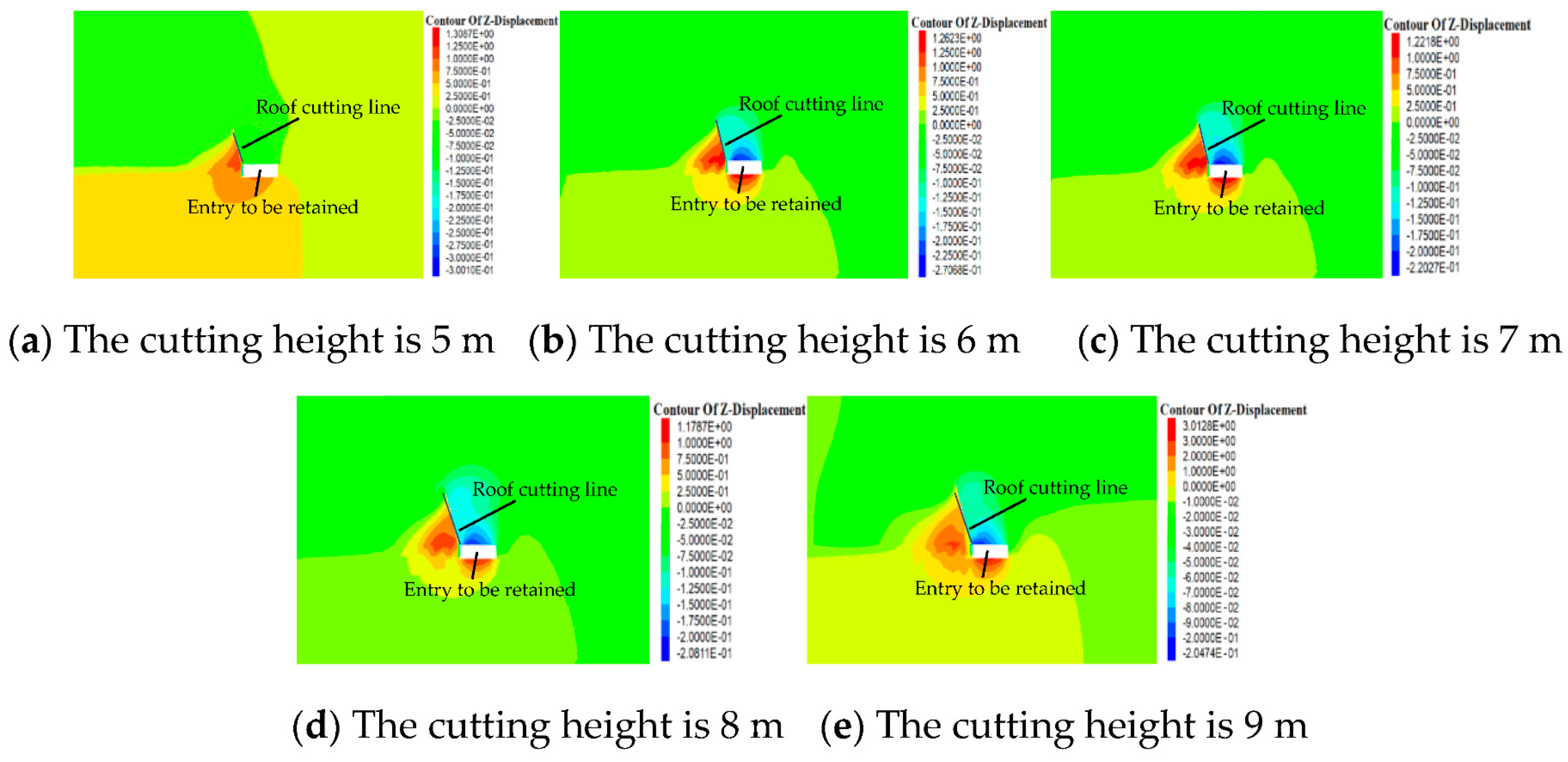
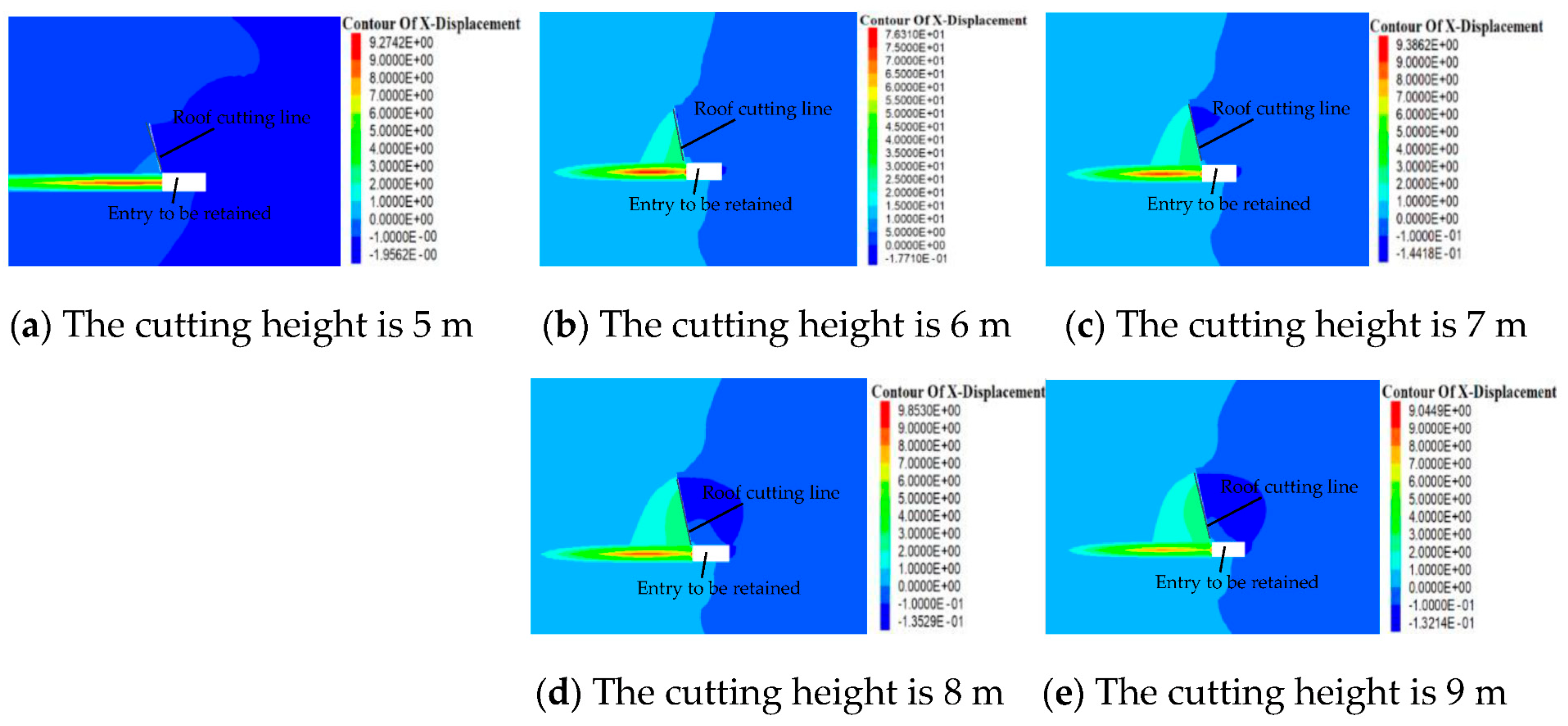
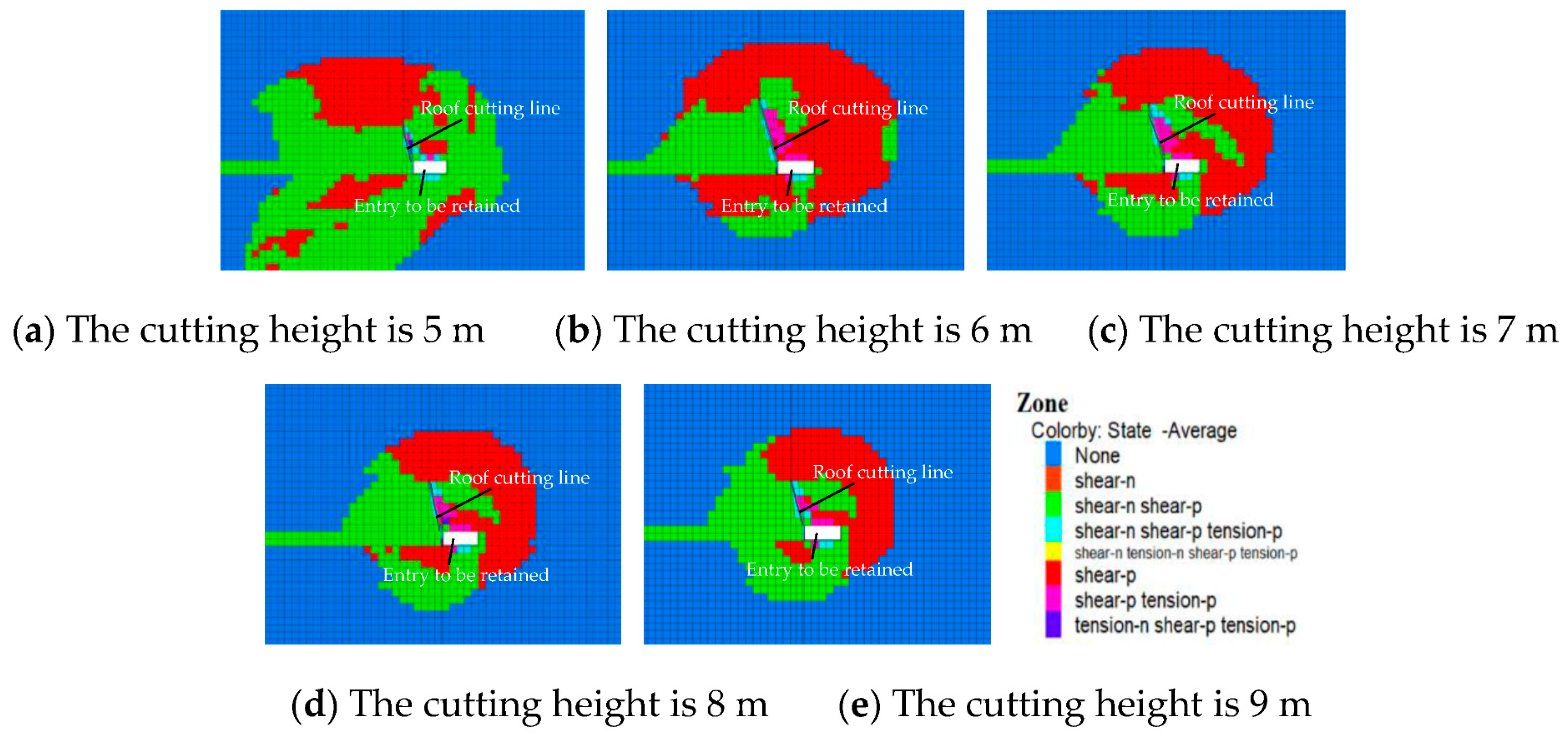
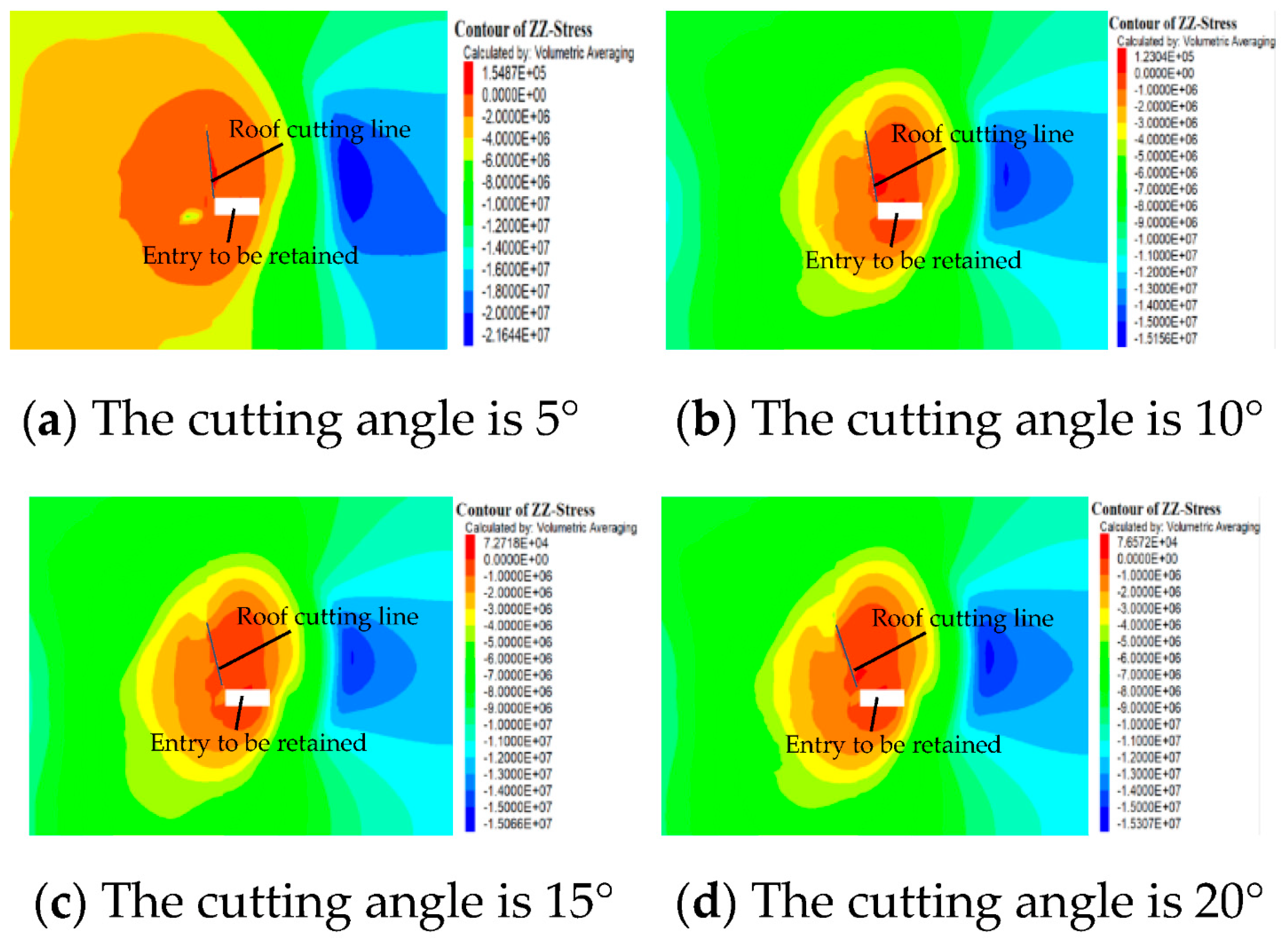
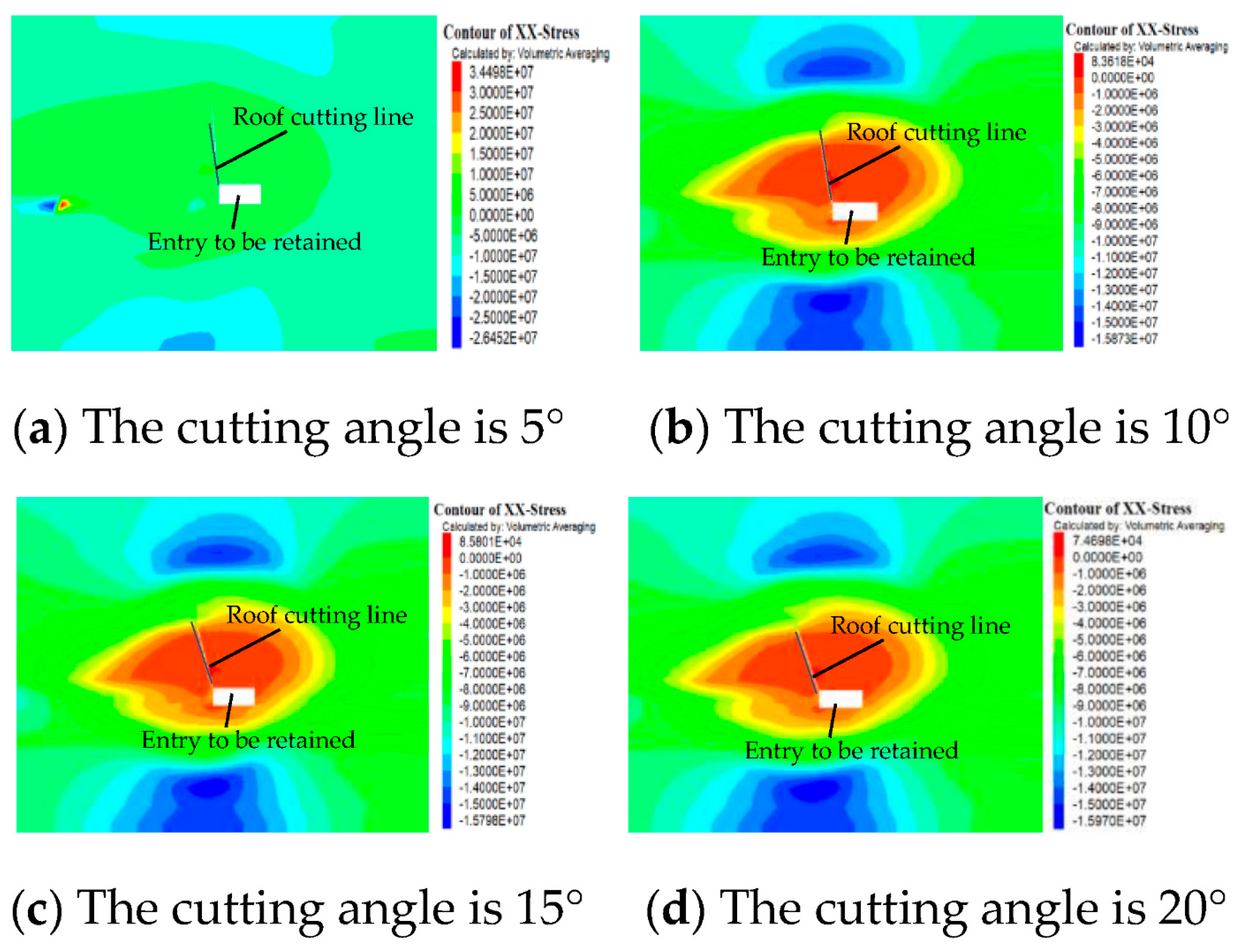
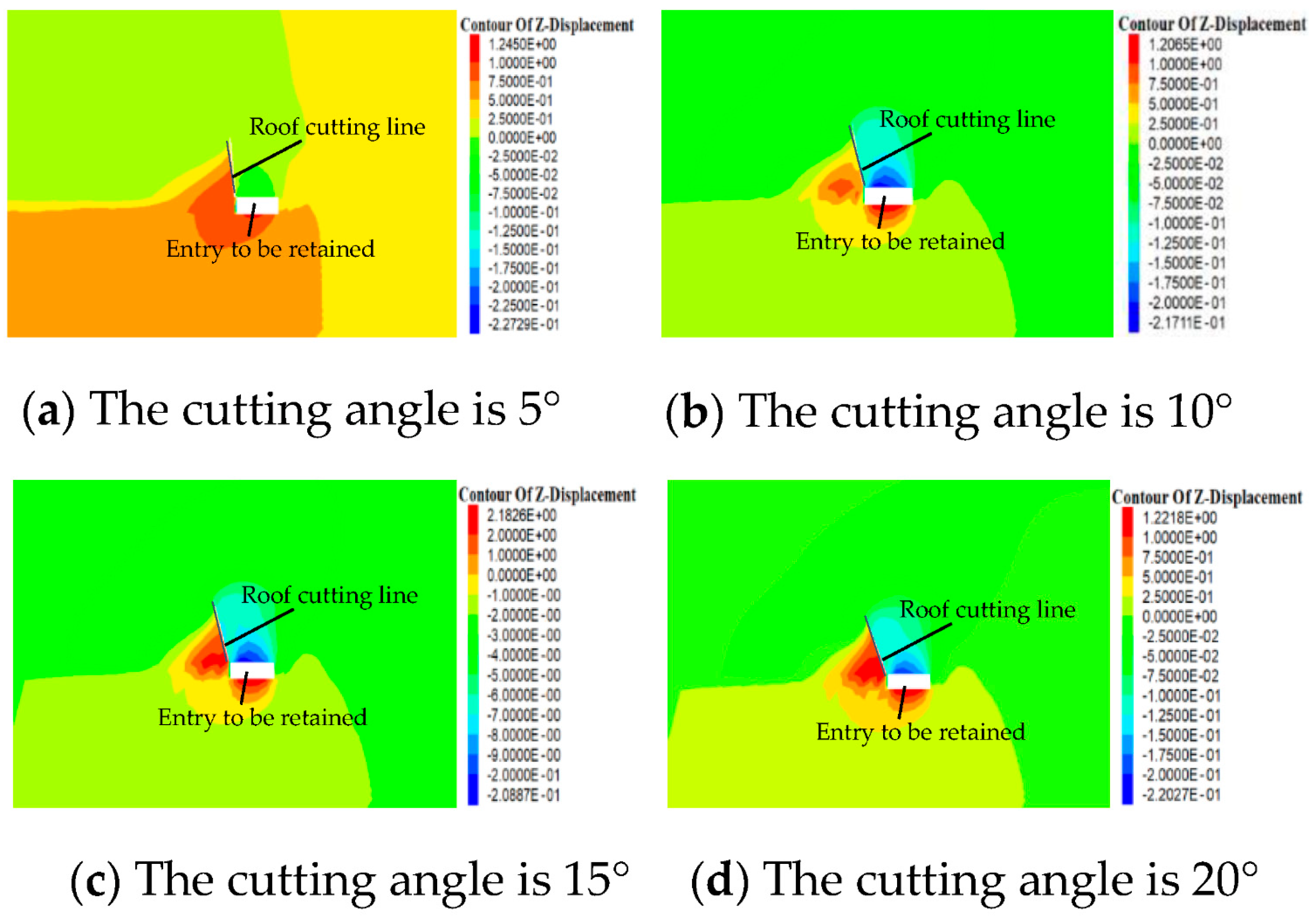
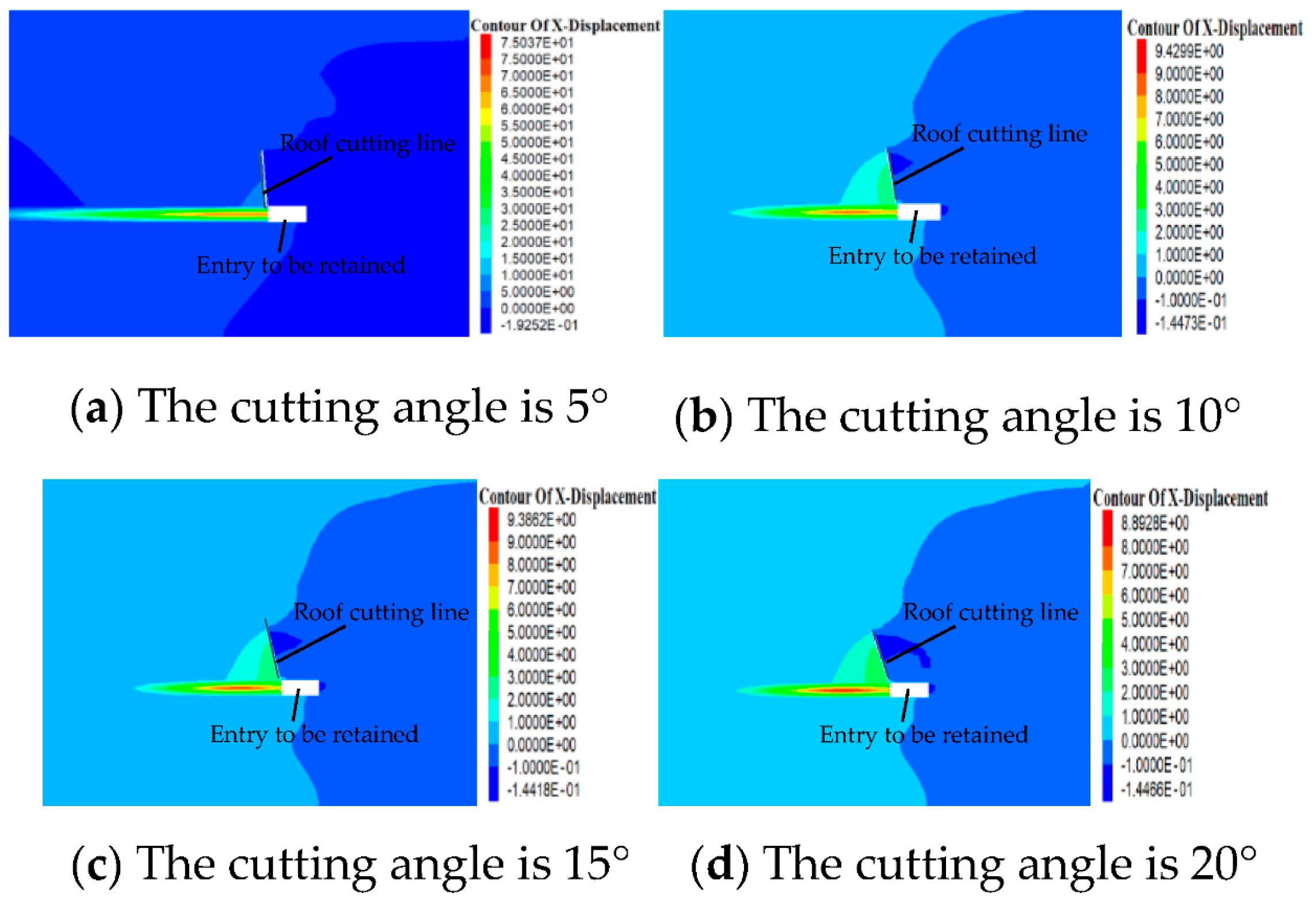



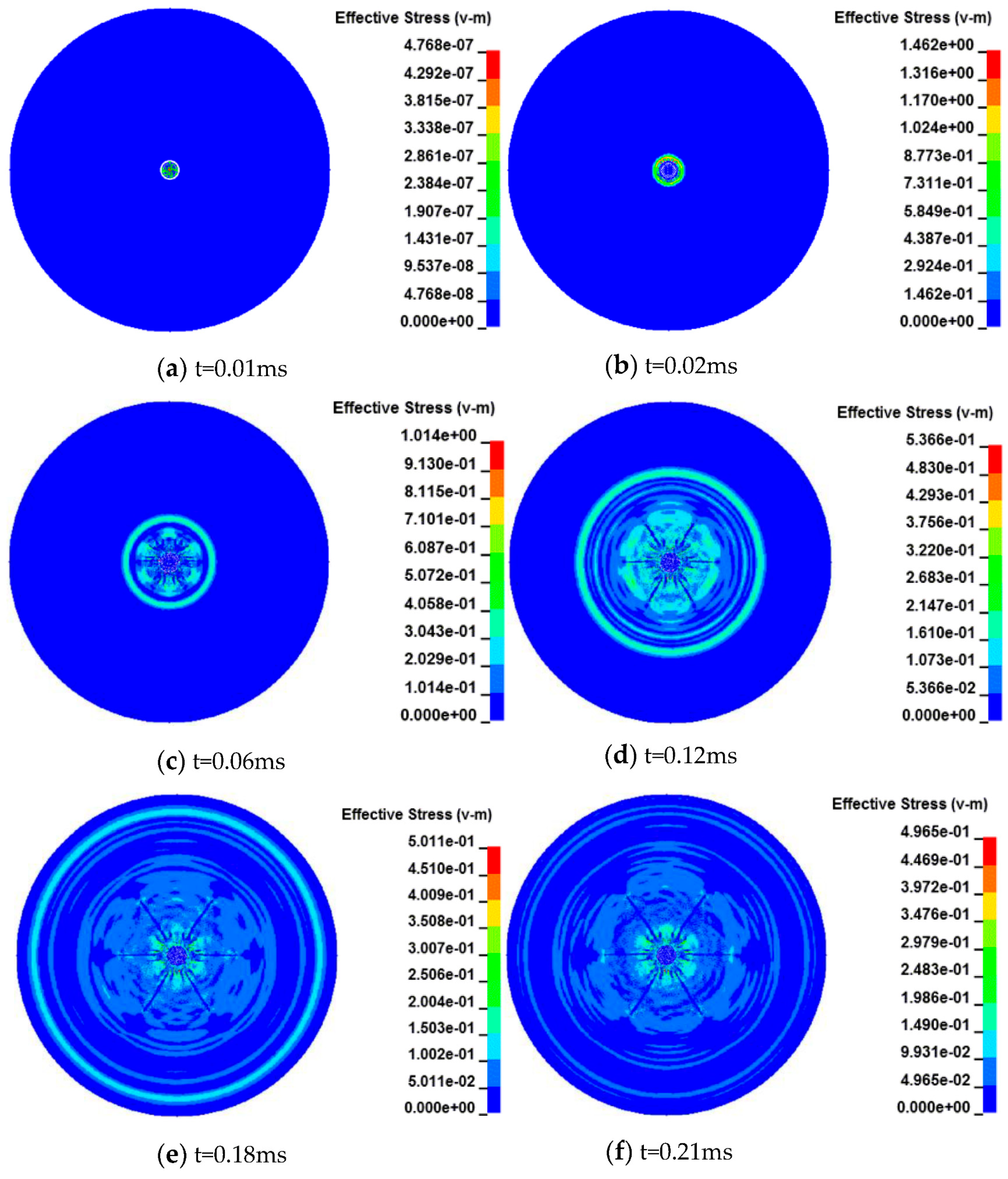

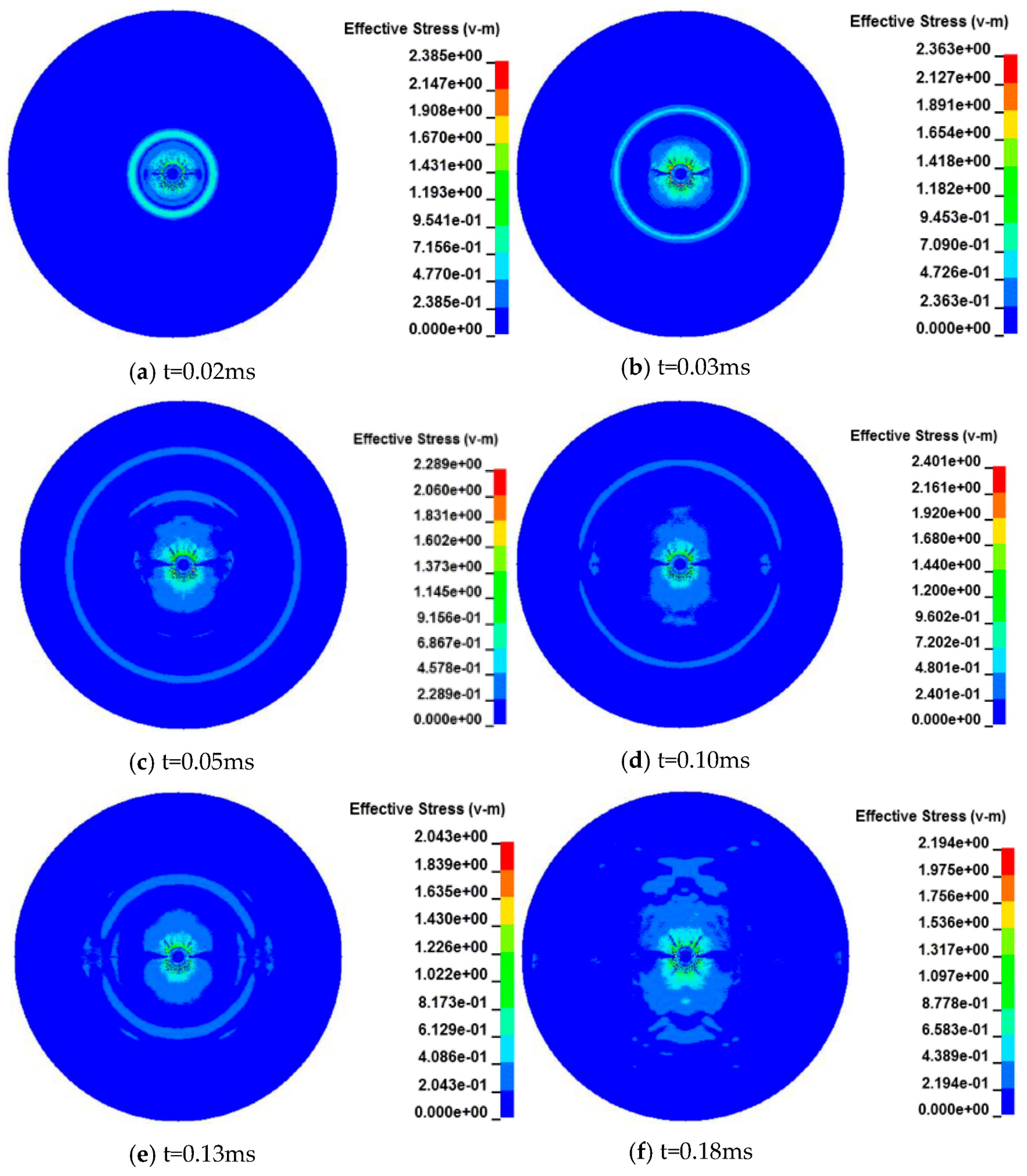
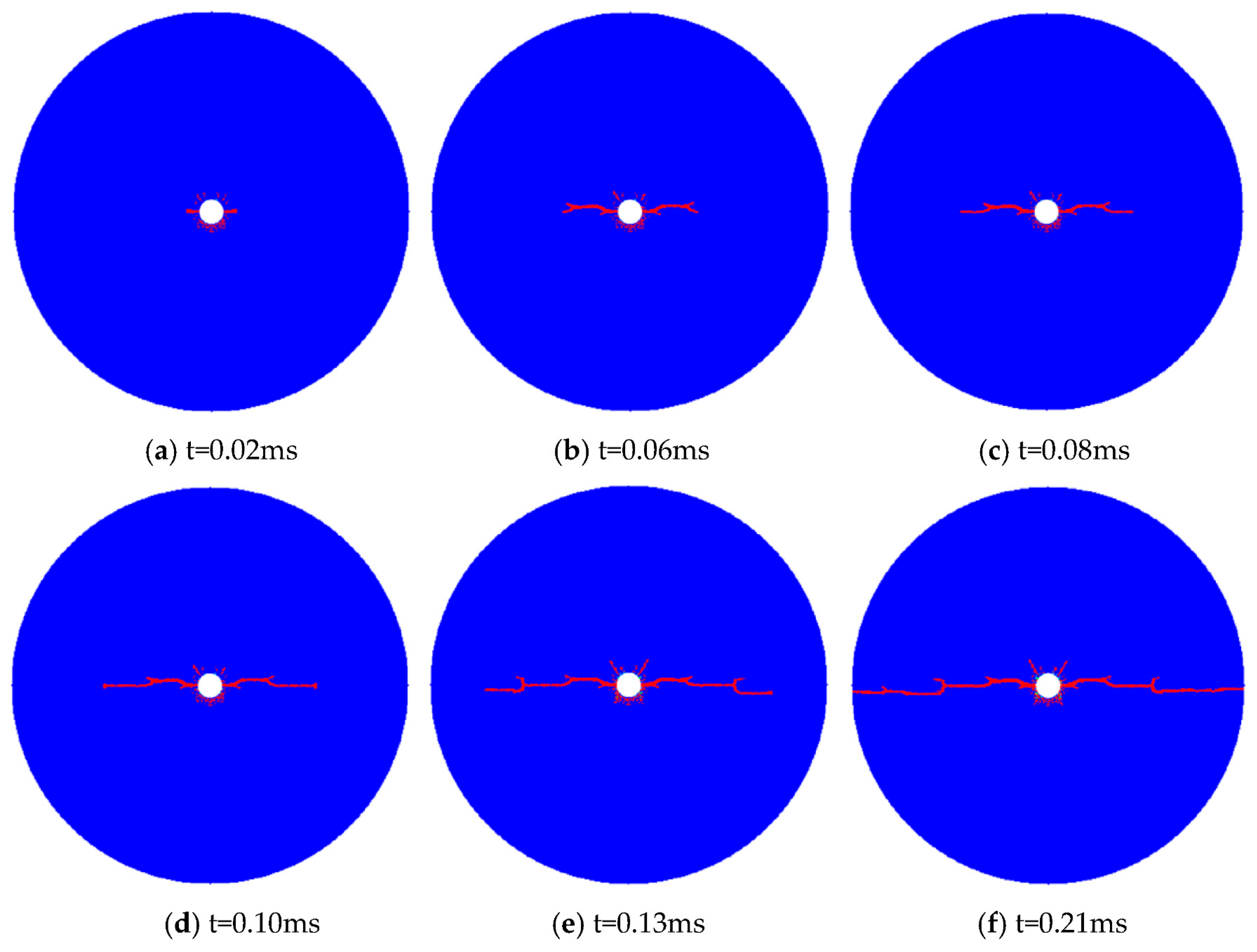
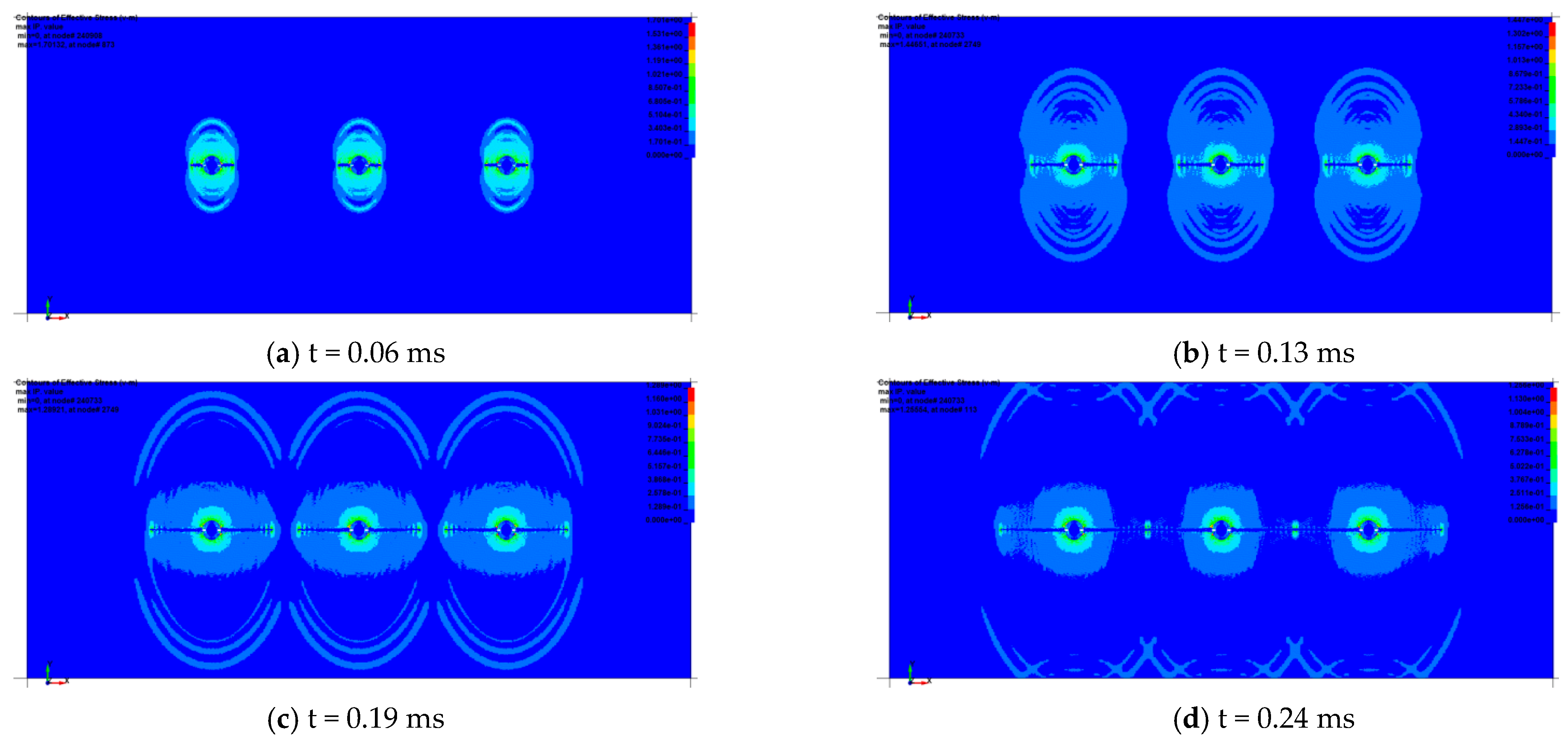
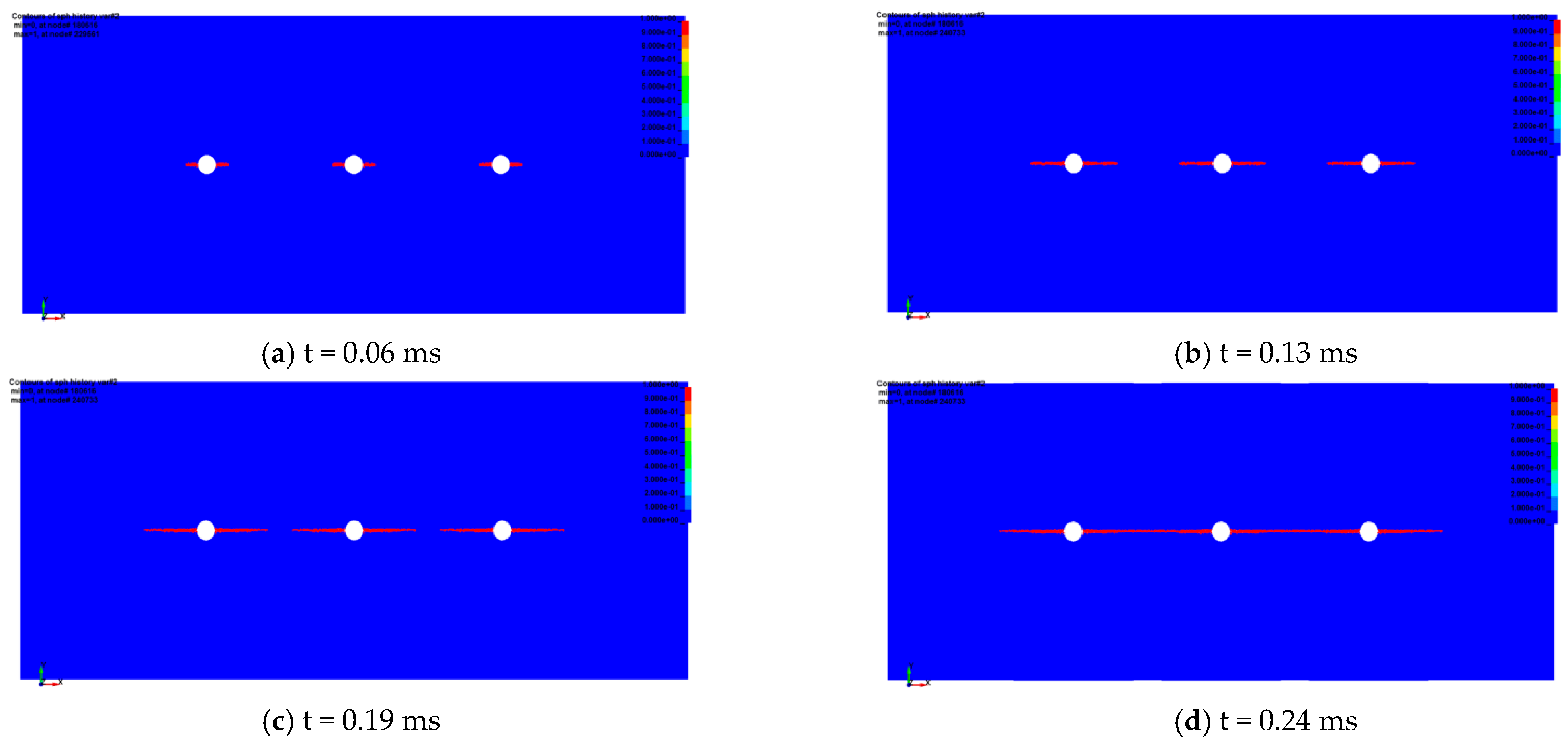


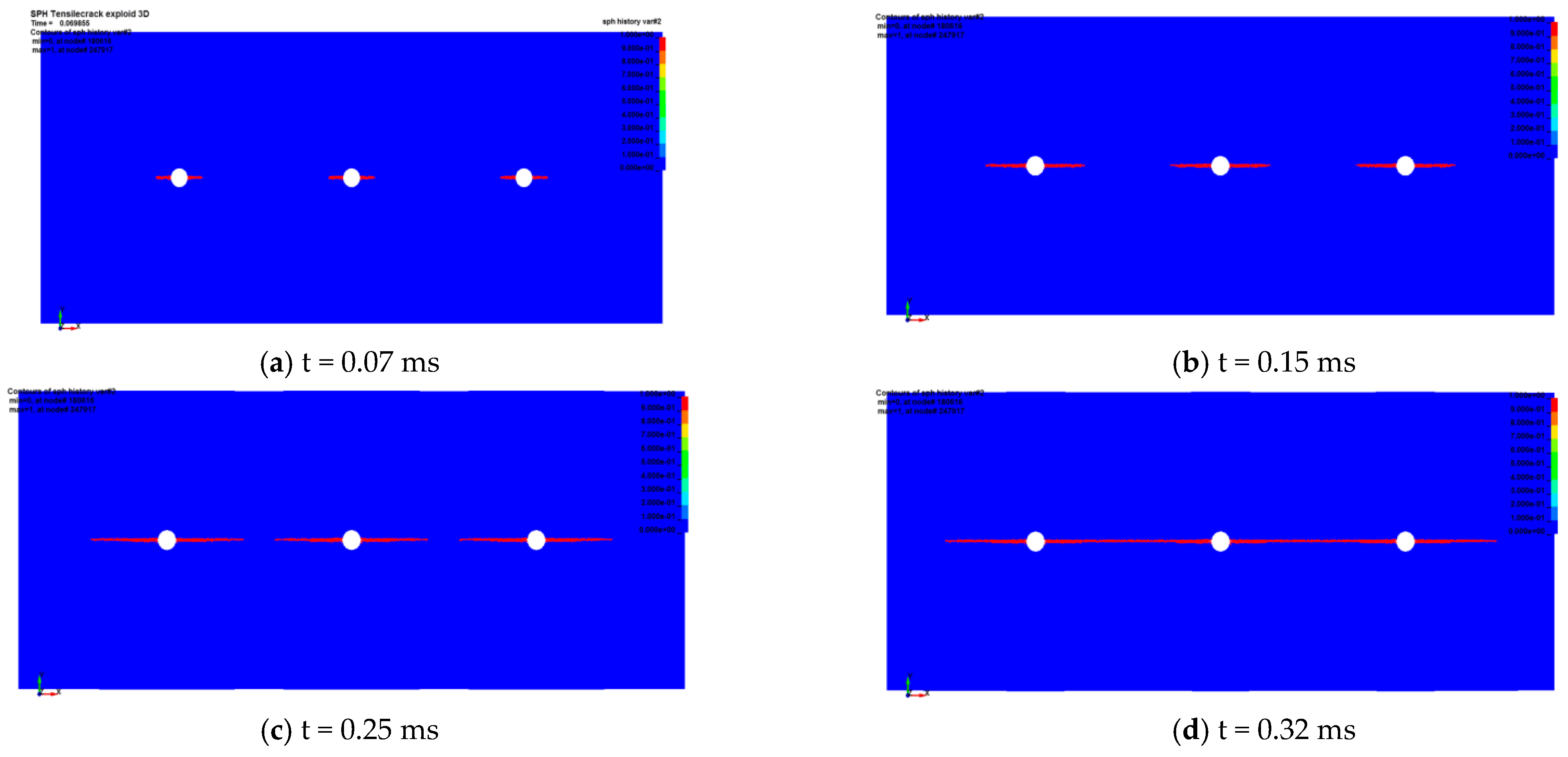
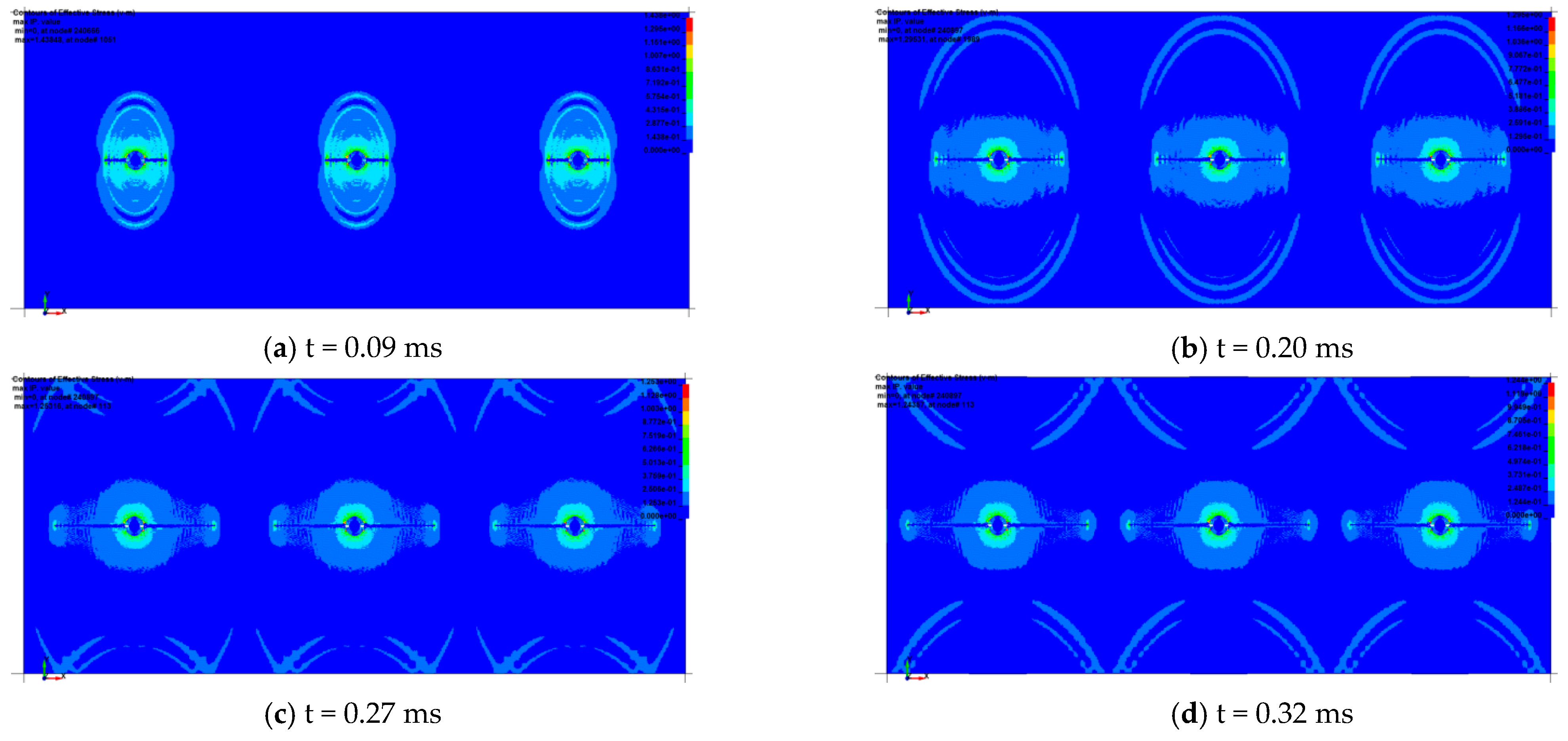
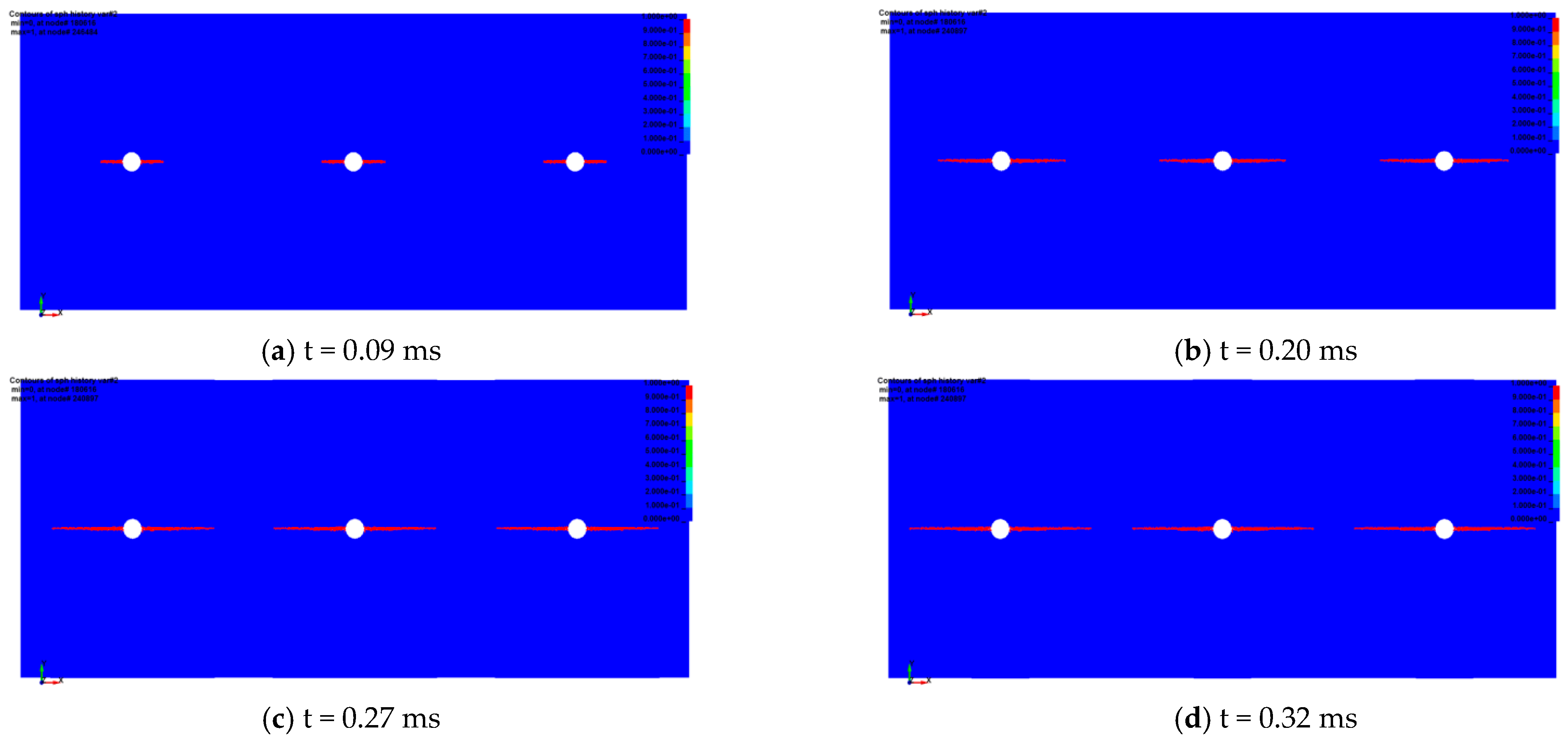
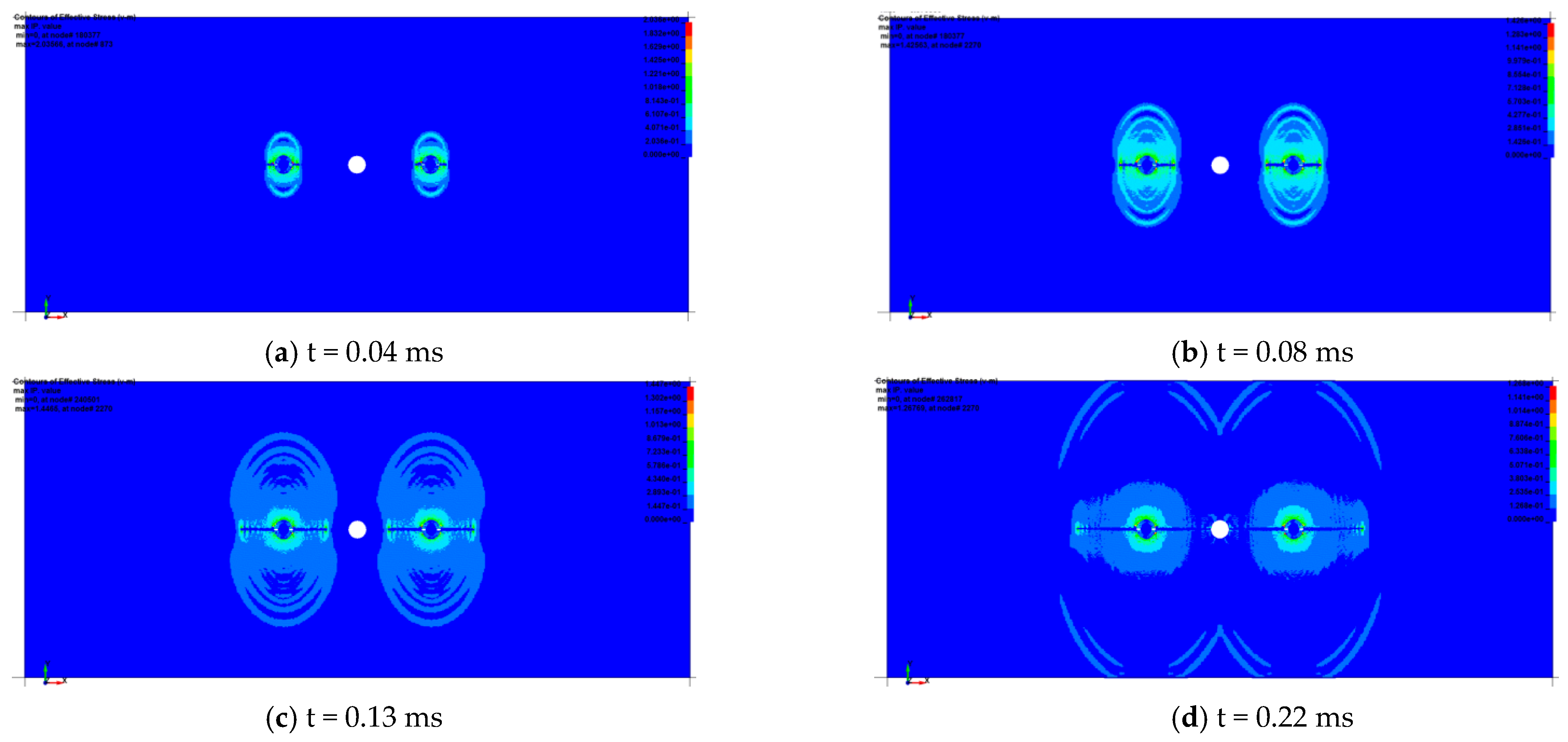
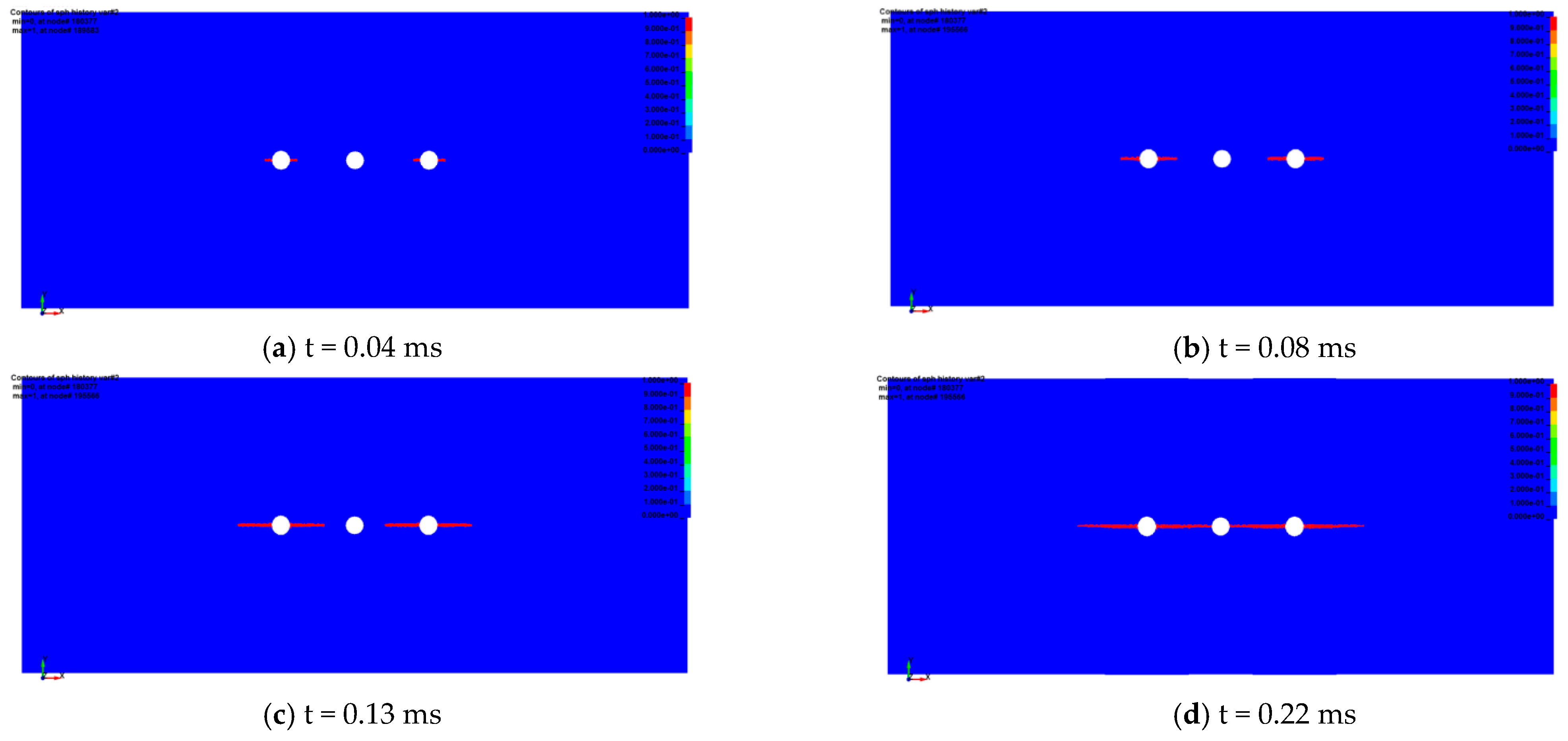



| Roof and Floor of Coal Seam | Roof and Floor Category | Rock Name | Lithological Characteristics |
|---|---|---|---|
| Basic roof | Silty mudstone | Light-grayish-green, thin- to medium-thick bedded, with horizontal bedding and uniform bedding. Joints and fissures are developed. A large number of calcite blocks are distributed at the top, with a small amount of pyrite distributed in a vein shape mixed with a thin silty mudstone layer, with slight squeezing and wrinkling. | |
| Direct roof | Pelitic siltstone | Light-purple grayish-black, thin- to medium-thick layered, with horizontal bedding and even bedding. Joints and fissures are developed, and a small amount of calcite veins were found. It contains a small amount of pyrite and a small amount of dark coal lineation. The bottom is slightly squeezed and crumpled. | |
| Direct floor | Pelitic siltstone | Light-purple grayish-black, thin- to medium-thick layered, with horizontal bedding, oblique bedding, and a small amount of cross bedding. Joints and fissures are developed. A small siderite strip is included. Produced a small amount of carbonized plant stems and stems. | |
| Basic floor | Silty mudstone | Light-grayish-green, thin- to medium-thick bedded, with horizontal bedding and oblique bedding. Joints are developed with several thin layers of mudstone. |
| Rock Stratum Category | Thickness/m | Bulk Modulus /109 Pa | Shear Modulus /109 Pa | Internal Friction Angle/° | Tensile Strength /106 Pa | Bulk Density /103 kg/m3 | Cohesion /106 Pa |
|---|---|---|---|---|---|---|---|
| Overlying strata | 21 | 13.1 | 18.5 | 36 | 3.92 | 2.5 | 3.88 |
| Pelitic siltstone | 7 | 9.7 | 14.5 | 33 | 1.92 | 2.1 | 1.88 |
| Silty mudstone | 7 | 12.1 | 20.5 | 36 | 2.92 | 2.3 | 3.28 |
| Carbonaceous mudstone | 2 | 10.1 | 18.5 | 34 | 2.32 | 2.1 | 2.28 |
| Pelitic siltstone | 7 | 9.7 | 14.5 | 33 | 1.92 | 2.1 | 1.88 |
| Coal C2 | 2 | 8.1 | 12.2 | 31 | 1.69 | 1.4 | 1.71 |
| Pelitic siltstone | 5 | 9.7 | 14.5 | 33 | 1.92 | 2.1 | 1.88 |
| Coal C3 | 1 | 8.1 | 12.2 | 31 | 1.69 | 1.4 | 1.71 |
| Silty mudstone | 6 | 12.1 | 20.5 | 36 | 2.92 | 2.3 | 3.28 |
| Siltstone | 2 | 11.1 | 15.5 | 35 | 2.52 | 2.2 | 2.55 |
| Explosive Density/g·cm−3 | Detonation Velocity/m·s−1 | Gas Pressure/KPa | A/KPa | B/KPa | R1 | R2 | w | E0/GPa |
|---|---|---|---|---|---|---|---|---|
| 1.2 | 3800 | 2.7e7 | 3.26e8 | 5.81e6 | 5.81 | 1.56 | 0.57 | 2.67 × 106 |
| Material Density/g·cm−3 | Elastic Modulus /GPa | Shear Modulus /GPa | Yield Stress /MPa | Poisson’s Ratio |
|---|---|---|---|---|
| 1.43 | 43 | 3.2 | 61.7 | 0.32 |
| ρ/g·cm−3 | C4 | C5 |
|---|---|---|
| 1.29 × 10−3 | 0.04 | 0.04 |
Disclaimer/Publisher’s Note: The statements, opinions and data contained in all publications are solely those of the individual author(s) and contributor(s) and not of MDPI and/or the editor(s). MDPI and/or the editor(s) disclaim responsibility for any injury to people or property resulting from any ideas, methods, instructions or products referred to in the content. |
© 2023 by the authors. Licensee MDPI, Basel, Switzerland. This article is an open access article distributed under the terms and conditions of the Creative Commons Attribution (CC BY) license (https://creativecommons.org/licenses/by/4.0/).
Share and Cite
Ma, X.; He, M.; Hu, B.; Wang, D.; Chen, C.; Li, J.; Gao, J.; Jiang, Q.; Bai, Z. Study on Key Parameter Design and Adaptability Technology of the 110 Mining Method for the Yuwang NO.1 Coal Mine in the Diandong Mining Area. Minerals 2023, 13, 176. https://doi.org/10.3390/min13020176
Ma X, He M, Hu B, Wang D, Chen C, Li J, Gao J, Jiang Q, Bai Z. Study on Key Parameter Design and Adaptability Technology of the 110 Mining Method for the Yuwang NO.1 Coal Mine in the Diandong Mining Area. Minerals. 2023; 13(2):176. https://doi.org/10.3390/min13020176
Chicago/Turabian StyleMa, Xingen, Manchao He, Bing Hu, Dalong Wang, Cunqiang Chen, Jing Li, Jianxun Gao, Qi Jiang, and Zongrong Bai. 2023. "Study on Key Parameter Design and Adaptability Technology of the 110 Mining Method for the Yuwang NO.1 Coal Mine in the Diandong Mining Area" Minerals 13, no. 2: 176. https://doi.org/10.3390/min13020176
APA StyleMa, X., He, M., Hu, B., Wang, D., Chen, C., Li, J., Gao, J., Jiang, Q., & Bai, Z. (2023). Study on Key Parameter Design and Adaptability Technology of the 110 Mining Method for the Yuwang NO.1 Coal Mine in the Diandong Mining Area. Minerals, 13(2), 176. https://doi.org/10.3390/min13020176








